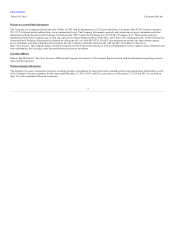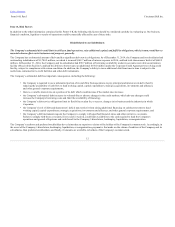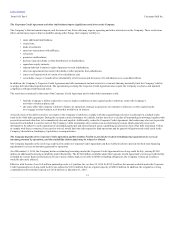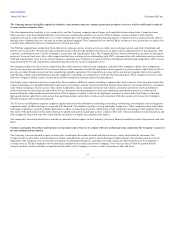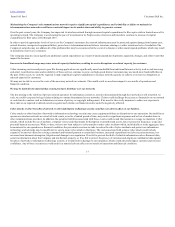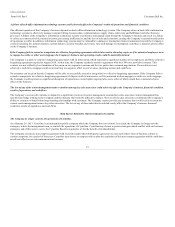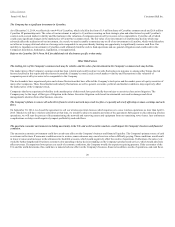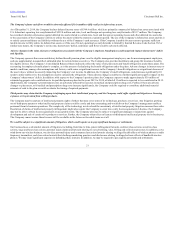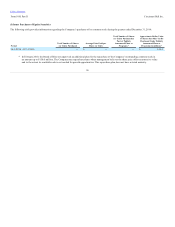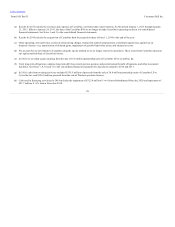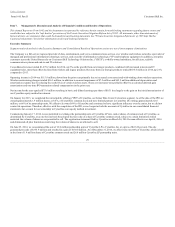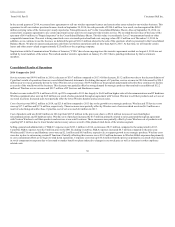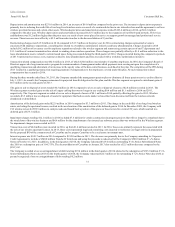Cincinnati Bell 2014 Annual Report Download - page 21
Download and view the complete annual report
Please find page 21 of the 2014 Cincinnati Bell annual report below. You can navigate through the pages in the report by either clicking on the pages listed below, or by using the keyword search tool below to find specific information within the annual report.
Table of Contents
Form 10-K Part I
Cincinnati Bell Inc.
The Company’s future cash flows would be adversely affected if it is unable to fully realize its deferred tax assets.
As of December 31, 2014, the Company had net deferred income taxes of $369.6 million, which are primarily composed of deferred tax assets associated with
U.S. federal net operating loss carryforwards of $232.8 million and state, local and foreign net operating loss carryforwards of $53.7 million. The Company
has recorded valuation allowances against deferred tax assets related to certain state, local and foreign net operating losses and other deferred tax assets due
to the uncertainty of the Company’s ability to utilize the assets within the statutory expiration period. The use of the Company’s deferred tax assets enables it
to satisfy current and future tax liabilities without the use of the Company’s cash resources. If the Company is unable for any reason to generate sufficient
taxable income to fully realize its deferred tax assets, or if the use of its net operating loss carryforwards is limited by Internal Revenue Code Section 382 or
similar state statute, the Company’s net income, shareowners’ deficit, and future cash flows would be adversely affected.
Adverse changes in the value of assets or obligations associated with the Company’s employee benefit plans could negatively impact shareowners’ deficit
and liquidity.
The Company sponsors three noncontributory defined benefit pension plans: one for eligible management employees, one for non-management employees,
and one supplemental, nonqualified, unfunded plan for certain former executives. The Company also provides healthcare and group life insurance benefits
for eligible retirees. The Company’s Consolidated Balance Sheets indirectly reflect the value of all plan assets and benefit obligations under these plans. The
accounting for employee benefit plans is complex, as is the process of calculating the benefit obligations under the plans. Adverse changes in interest rates or
market conditions, among other assumptions and factors, could cause a significant increase in the Company’s benefit obligations or a significant decrease of
the asset values, without necessarily impacting the Company’s net income. In addition, the Company’s benefit obligations could increase significantly if it
needs to unfavorably revise the assumptions used to calculate the obligations. These adverse changes could have a further significant negative impact on the
Company’s shareowners’ deficit. In addition, with respect to the Company’s pension plans, the Company expects to make approximately $30 million of
estimated aggregate cash contributions to its qualified pension plans for the years 2015 to 2018, of which $13 million is expected to be contributed in 2015.
Additionally, the Company’s postretirement costs are adversely affected by increases in medical and prescription drug costs. Further, if there are adverse
changes to plan assets, or if medical and prescription drug costs increase significantly, the Company could be required to contribute additional material
amounts of cash to the plan or could accelerate the timing of required payments.
Third parties may claim that the Company is infringing upon their intellectual property, and the Company could suffer significant litigation or licensing
expenses or be prevented from selling products.
The Company may be unaware of intellectual property rights of others that may cover some of its technology, products, or services. Any litigation growing
out of third-party patents or other intellectual property claims could be costly and time-consuming and would divert the Company’s management and key
personnel from its business operations. The complexity of the technology involved and the uncertainty of intellectual property litigation increase these risks.
Resolution of claims of intellectual property infringement might also require the Company to enter into costly license agreements. Likewise, the Company
may not be able to obtain license agreements on acceptable terms. The Company also may be subject to significant damages or injunctions against
development and sale of certain of its products or services. Further, the Company often relies on licenses of third-party intellectual property for its businesses.
The Company cannot ensure these licenses will be available in the future on favorable terms or at all.
We could be subject to a significant amount of litigation, which could require us to pay significant damages or settlements.
Our business faces a substantial amount of litigation, including, from time to time, patent infringement lawsuits, antitrust class actions, securities class
actions, wage and hour class actions, personal injury claims and lawsuits relating to our advertising, sales, billing and collection processes. In addition, as we
wind down our wireless business, we also face personal injury and consumer class action lawsuits relating to alleged health effects of wireless phones or radio
frequency transmitters, and class action lawsuits that challenge marketing practices and disclosures relating to alleged adverse effects of handheld wireless
phones. We may incur significant expenses in defending these lawsuits. In addition, we may be required to pay significant awards and settlements.
21


